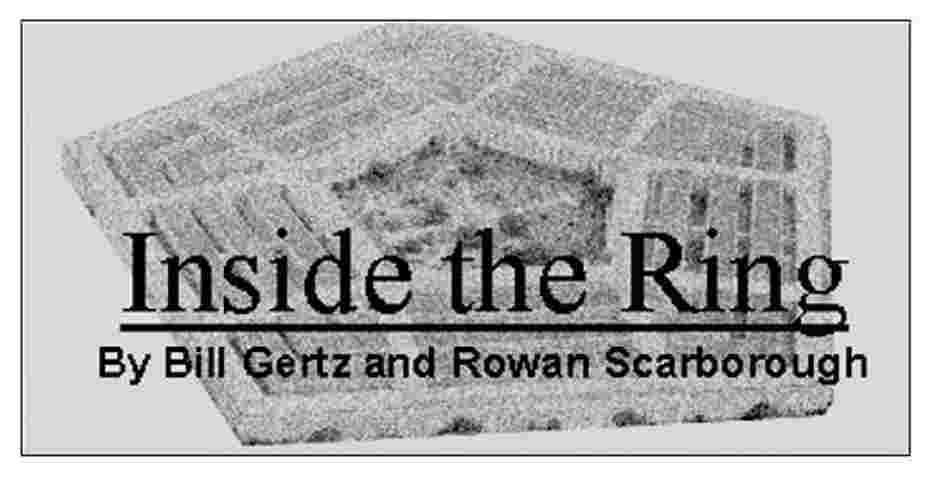|
Return to
|

|
January 19, 2001
Notes from the PentagonChina prepThe Pentagon recently monitored a Chinese military exercise that provided new insights into plans by the People's Liberation Army (PLA) for action against Taiwan. U.S. intelligence agencies detected military operations, both naval and ground force movements, involving a mock seaborne blockade against the island. What was unusual about the exercises, according to intelligence officials, was that the scenario included the positioning of two U.S. aircraft carrier battle groups to waters near Taiwan. "The carriers just sat there," said one official. The Chinese military's assumption that the carriers and warships did not intervene to break the blockade in defense of Taiwan alarmed some analysts. The reason: It showed the Chinese military does not believe that the United States military is prepared to defend the island in that particular attack scenario. This has raised new fears of some type of miscalculation by the Chinese that could lead to direct U.S. involvement in a regional conflict with Beijing. The September exercise came seven months after Adm. Dennis Blair met privately in Beijing with top PLA generals. The Pacific commander told them that if China attacks Taiwan, the United States is prepared to defend the island. The Chinese generals' response was to dismiss the statement as "a laughable bluster," one official told us. Chinese doubts about U.S. resolve stem from the failure of the U.S. military to conduct any military exercises with Taiwan and the fact that U.S. warships never visit Taiwanese ports. The recent PLA exercise bolsters the claims of conservative defense analysts in Congress, who say the Clinton administration policy of ignoring Taiwan in pursuit of better relations with Beijing has increased instability on the Taiwan Strait. Congress sought to remedy the problem last year with the Taiwan Security Enhancement Act, which aims to increase U.S. defense cooperation with the island. The bill passed the House and had support from President-elect George W. Bush during the presidential campaign. A naval blockade was one of three methods outlined in a Pentagon report made public last month that would be used by China in a potential attack against Taiwan. In addition to a blockade, the Pentagon believes an attack on Taiwan could also be carried out as a massive missile strike designed to cripple Taiwan, and as an amphibious assault. The Pentagon report said that intelligence gaps had prevented analysts from predicting the outcome of a China Strait conflict.
Don't mess with Don Richard L. Garwin, a noted physicist and national security authority, served on the commission. He tells us that when CIA Director George Tenet balked at showing the panel secret data on worldwide missile developments, Mr. Rumsfeld did not take "no" for an answer. "It took about six weeks before George Tenet saw the light and became very cooperative," Mr. Garwin said. "Rumsfeld explained that this was the law and the CIA had no choice. It was due to Rumsfeld's aggressive, but effective, intervention that we did get this." Mr. Garwin differs with Mr. Rumsfeld on what type of defense is needed against ballistic missiles. Still, the two worked collegially on the 1998 commission. "He knew what he wanted to do, but in this case he was perfectly open. Otherwise, I would not have served with him," said Mr. Garwin, a senior fellow at the Council on Foreign Relations. "He listened to every commission member and accepted modification until everyone was satisfied with the report." Ironically, Mr. Rumsfeld faces some of the exact same readiness problems today that the armed force suffered through in 1975 and 1976 when he led the Pentagon under President Ford. In a 1976 report, Mr. Rumsfeld complained that "too many tactical aircraft are grounded awaiting repair, which in too many instances is delayed because spare parts are lacking. . . . The materiel readiness of U.S. land forces is improving, but remains substandard in some important respects." Today, the Joint Chiefs of Staff say the Air Force, Army, Navy and Marine Corps need $50 billion in new annual spending to fix spare-parts shortages, replace aging aircraft and equipment, and meet recruiting goals.
Air Force doldrums In a transition update book dated Jan. 10, the Air Force said squadrons still lack sufficient spare parts and see a downward trend in mission capable rates. Some highlights:
In addition to these problems, the Air Force continues to operate with a significant pilot shortage. Of 13,400 pilot slots, 1,200 are vacant and a "significant shortfall" is projected over the next five years, the service says.
Solidarity Mr. Bush, an ex-Air National Guard fighter pilot, pledged during the presidential campaign to rebuild military readiness and set a good example as commander in chief. He paid his first visit to the Pentagon last week as president-elect, sitting down in the secure "tank" to discuss worldwide trouble spots with the Joint Chiefs of Staff. "There is some talk about [it] in the building, but little specifics, unfortunately," said one officer. "You probably saw that Bush visited the Pentagon, largely to visit with the senior leadership and transition staff. I expect he'll be here much more often than his predecessor." In other transition developments, Republicans say William Schneider Jr. will likely take a senior post at the Pentagon, but not immediately. Defense-Secretary-nominee Donald H. Rumsfeld brought him in to take over what sources say was an "unfocused" transition effort. Sources said Mr. Schneider, a former undersecretary of state in the Reagan administration, has obligations in the private sector that could delay him for six months or so from taking a Pentagon post.
|
|
Inside the Ring Archives
1999 Columns 2000 Columns 2001 Columns |